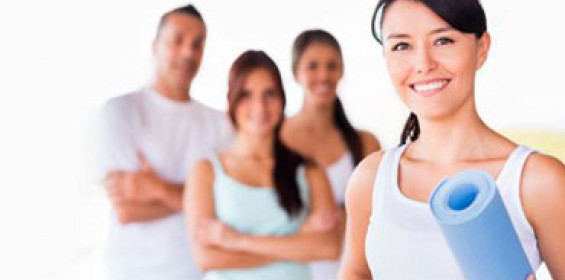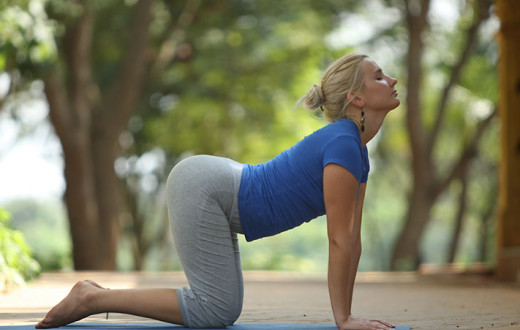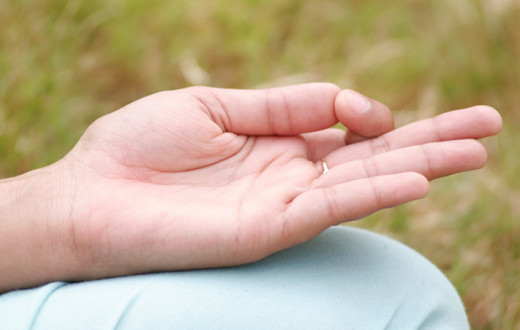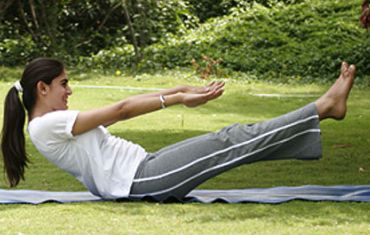Pronounced : Oohs-tra-aa-sun-aa
Ustra = Camel : Asana = Posture or Pose
Ustrasana is an intermediate level back-bending yoga posture known to open Anahata (Heart chakra). This yoga posture adds flexibility and strength to the body and also helps in improving digestion.
How to do Camel Pose (Ustrasana)
- Kneel on the yoga mat and place your hands on the hips.
- Your knees should be in line with the shoulders and the sole of your feet should be facing the ceiling.
- As you inhale, draw in your tail-bone towards the pubis as if being pulled from the navel.
- Simultaneously, arch your back and slide your palms over your feet till the arms are straight.
- Do not strain or flex your neck but keep it in a neutral position.
- Stay in this posture for a couple of breaths.
- Breathe out and slowly come back to the initial pose. Withdraw your hands and bring them back to your hips as you straighten up.
Camel Pose (Ustrasana) for Beginners
- You may place a cushion below your knees to ease your way into the pose.
Benefits of the Camel Pose (Ustrasana)
- Improves digestion.
- Stretches and opens the front of the body. It also strengthens the back and shoulders.
- Relieves the body of lower back ache.
- Improves flexibility of the spine and also improves posture.
- Helps overcome menstrual discomfort.
Contraindications of the Camel Pose
- Back injury or neck injury, high or low blood pressure: Perform this pose only with the supervision of an experienced teacher.
Follow-up Poses
Ustrasana can be followed up with Setu Bandhasana.
Yoga practice helps develop the body and mind bringing a lot of health benefits yet is not a substitute for medicine. It is important to learn and practice yoga postures under the supervision of a trained Sri Sri Yoga teacher. In case of any medical condition, practice yoga postures after consulting a doctor and an Sri Sri Yoga teacher. Find an Sri Sri Yoga course at an Art of Living Center near you. Do you need information on courses or share feedback? Write to us at info@srisriyoga.in
FAQ's on Ustrasana
Ustrasana is a back-bending yoga posture of an intermediate level. It is known to open Anahata (Heart chakra).
Ustrasana improves digestion. It adds flexibility and strength to the body.
Ustrasana is called camel pose as this back-bending yoga posture takes the shape of a camel. In this pose, the whole front of the body stretches backward. In Sanskrit, ustra means camel asana means pose
"Benefits of Camel pose (Ustrasana) *It improves digestion *It opens and stretches the front of the body thus strengthen the back and shoulders *It relieves the body of lower back-ache *Spine becomes flexible and posture improves *Relieves you from menstrual discomfort"
"Beginners can practice Ustrasana by placing a cushion below their knees for comfort. *Kneel on a yoga mat with the sole of your feet facing the ceiling. Place hands on hips. *Inhale to draw in your tailbone towards the pubis as if being pulled from the navel. *Simultaneously, arch your back and slide your palms over your feet till the arms are straight *Do not strain your neck *Stay in this posture and breathe a couple of times *Breathe out and slowly come back to the initial pose *Withdraw your hands and bring them back to your hips as you straighten up."
"Follow the steps to do Ustrasana: *Kneel on a yoga mat with the sole of your feet facing the ceiling. Place hands on hips. *Inhale to draw in your tailbone towards the pubis as if being pulled from the navel. *Simultaneously, arch your back and slide your palms over your feet till the arms are straight *Do not strain your neck *Stay in this posture and breathe a couple of times *Breathe out and slowly come back to the initial pose *Withdraw your hands and bring them back to your hips as you straighten up *Beginners can practice Ustrasana by placing a cushion below knees for comfort. "
"Matsyasana is a reclining back-bending asana. In Sanskrit matsya, means fish and asana, means pose. Benefits of Matsyasana are: *Stretches the chest, neck, and hip flexors *Relieves tension in the neck and shoulders *Stretches and stimulates muscles of the belly and throat *Relieves from respiratory disorders by encouraging deep breathing *Tones the parathyroid, pituitary, and pineal glands"
Ustrasana should be done in menstrual discomfort, to improve digestion, relieve backache and strengthen the back and shoulders.
"Follow the steps to do Butterfly pose: *Begin in a seated position. Sit against a wall for spinal support. *Gently bend your knees and press the soles of your feet together. *Grab your feet tightly with your hands. You may place the hands underneath the feet for support. *Make an effort to bring the heels as close to the genitals as possible. *Lengthen your spine and broaden across your chest. *Take a deep breath in. Breathing out, press the thighs and knees downward towards the floor. *Now start flapping both the legs up and down like the wings of a butterfly. Start slow and gradually increase the speed. *Slow down and then stop. Take a deep breath in and as you exhale, bend forward, keeping the chin up and spine erect. *Press your elbows on the thighs or the knees, pushing the knees and thighs closer to the floor. *Feel the stretch in the inner thighs and take long, deep breaths, relaxing the muscles more and more. *Take a deep breath in and bring the torso up. *As you exhale, gently release the posture. Straighten the legs out in front of you and relax. "
"Contraindications of Ustrasana: *Weak back, back injury, spondylitis, or neck injury *High or low blood pressure. Perform this pose only with the supervision of an experienced teacher."
The five elements of yoga are: prithvi (earth), jal (water), agni (fire), vayu (air), and akasha (ether or space)
Patanjali is regarded as the father of modern yoga. Tirumalai Krishnamacharya is also regarded as the father of modern yoga in the twentieth century.
Ustrasana can be done once or twice depending upon how many different asanas you have planned to do and your available time.
Do yoga in the evening on a light stomach i.e. at least 3-4 hours after meals. Some people experience more energy in the evening than in the morning. So go for it.
"There are many types of yoga in yogasana. Mainly 5 types of yoga are: Hath yoga Karma yoga Gyan yoga Bhakti yoga Raj Yoga"


























































